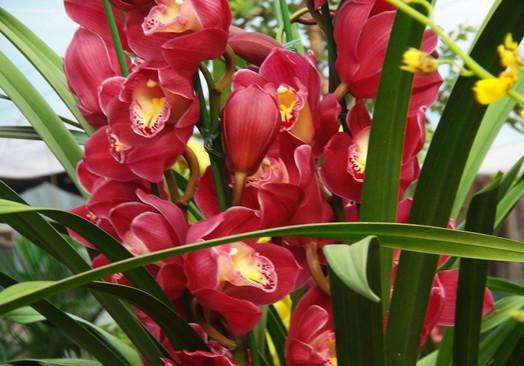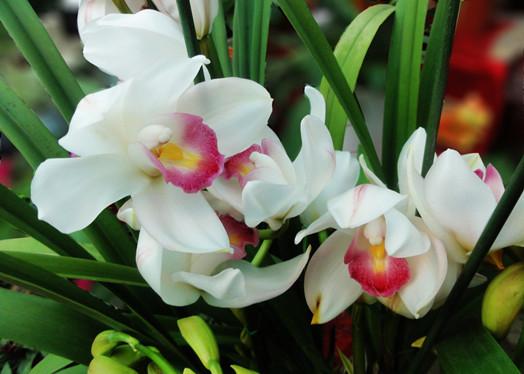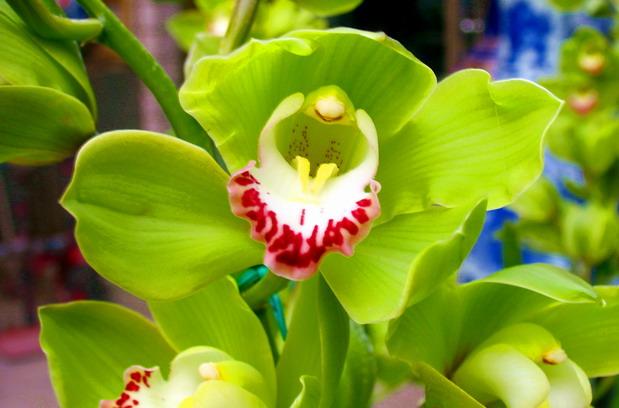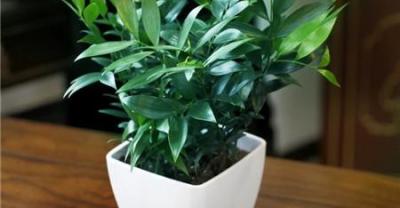Planting method and propagation of flowers-- Cymbidium grandiflorum
Cymbidium is the most common species of Cymbidium in the world. It is an artificial hybrid obtained from the hybridization of epiphytic species. It gets its name because it is similar to Cymbidium and has large flowers. The orchid with tall and straight stems, large flowers, dignified shape and magnificent momentum is one of the most widely cultivated high-grade orchids in the world. It is favored by people and enjoys a high reputation in the international and domestic orchid markets.

1. Substrate requirements for Cymbidium Culture
Cymbidium can be cultivated with fern root, peat, moss, bark, charcoal block, broken brick and so on.
Cymbal
two。 The methods of going up and changing pots for Cymbidium culture
As a rule, when the plant is too large, the pot should be changed or the ramet should be put on the pot to promote growth and flowering. Upper basin or change basin should be carried out after flowering or when the new buds are just sprouting in early spring. The method of changing the basin: pour the plant out of the old basin, cut off the rotten roots and yellow leaves, and remove the old matrix; put a layer of broken tiles or bricks at the bottom of the new urn to facilitate drainage and ventilation; put the plant in the basin, fill it with the new substrate, compact it with your hands and pour water through it.
3. Watering method of Cymbidium Culture
Cymbidium is a kind of flower that needs more water, especially in summer, it not only needs sufficient water, but also needs to spray water to the leaves to cool down and increase humidity. The inflated pseudobulb of Cymbidium has the function of water storage, so it has a certain degree of drought tolerance. But if it is not watered enough, the inflated pseudobulbs will shrink and affect normal growth. In addition, watering should be reduced during flowering, otherwise the flowers will appear brown spots.
4. Fertilization methods for the Culture of Cymbidium
In the vigorous growth period, rarefied fertilizer and water should be applied every 10 days or so, and little or no organic fertilizer should be applied in the seedling stage and low temperature season. Nitrogen, phosphorus and potassium compound fertilizer with a ratio of 7:6:19 can be used for foliar spraying. Cymbidium needs more fertilizer. If the nutrients are insufficient, the leaves will yellowed and fall off and the flowers will become smaller. Therefore, it is necessary to strengthen fertilization. Fertilization is applied once every 5-7 days in spring and summer, once every 10-15 days in autumn, and can be stopped in winter. During the growing period in spring and summer, the standard fertilizer diluted 1000 times of nitrogen, phosphorus and potassium should be applied, and more potash fertilizer should be used in autumn, which can be sprayed with 800-1000 times potassium dihydrogen phosphate.
Cymbal
5. Control of Diseases and insect pests in Cymbidium Culture
The main diseases of Cymbidium are leaf blight, anthracnose, soft rot and leaf spot, which can be controlled with 50% carbendan 500 times or 50% carbendazim 500 times, and soft rot and leaf spot can also be sprayed once a month with topiramate or chlorothalonil. The main pests are aphids, red spiders, shell insects and so on. 1000-fold solution of fenitrothion and omethoate EC can be used to control aphids, and 800-fold solution of triclofenac or dichlorvos can be used to control red spiders, once every 15 days.
6. Temperature requirements for Cymbidium Culture
Cymbidium prefers warm, cool, moist and semi-overcast environmental conditions. The suitable temperature for growth is 15-25 ℃. If the temperature is lower than 10 ℃ or higher than 35 ℃, it is better to enter dormancy, and the overwintering temperature is not lower than lO ℃. When the temperature difference between day and night is less than 10-15 ℃ in most varieties, flower bud differentiation can be carried out smoothly.
7. Matters needing attention in the Culture of Cymbidium
(1) compared with other orchids, Cymbidium prefers light, but can not be exposed to direct sunlight. Seedlings need 70% / 80% shade, 60% big seedlings, 40% / 50% shade in spring and autumn, 60% shade in summer, and more light after late autumn. to facilitate flower bud differentiation and bud blooming. The growth of Cymbidium needs high air humidity and sufficient moisture. The suitable air relative humidity for seedling growth is 80%, and the pH of water quality should be pH5.4~6; keeping the substrate moist in the peak growing season, often spraying water on plants and roots, and maintaining air humidity are beneficial to growth and development; there is a dormant period after flowering, and less watering is required.
(2) Cymbidium is the most fat-loving type of orchids. The flower bud differentiation period of Cymbidium is from August to September, and there must be obvious temperature difference in order to promote flower bud differentiation, that is, about 25 ℃ in daytime and 12-15 ℃ at night. If the night temperature exceeds 15 ℃ during flower bud germination, it will cause flower bud to wither. Good ventilation is a favorable condition affecting the growth and development of Cymbidium. For example, poor ventilation, especially in summer, is not conducive to the normal growth and development of Cymbidium, affecting the differentiation of flower buds, resulting in the phenomenon of only long leaves but no flowering.
Cymbal

8. Four Seasons Management of Cymbidium Culture
(1) Spring management
As the temperature begins to rise in spring, ventilation should be strengthened as much as possible to keep the flowering plants in a cooler environment. As the temperature changes greatly during the Spring Festival, do not rush to move it outdoors to protect and promote the growth of new buds, wait for sufficient light before moving to outdoor cultivation. Water should be watered once a day, while flowering plants can only keep the pot soil moist. Fertilize once every 10-15 days. Spring is a good time to change pots or ramet propagation after flowering, which should be implemented as soon as possible. In order to reduce nutrient consumption, the branches of the withered flowers should be cut off immediately, otherwise the growth of new buds will be affected.
(2) Summer management
Summer is the early stage of flower bud differentiation, because high temperature is not conducive to flower bud differentiation, so attention should be paid to cooling to promote flower bud differentiation. The temperature below 28 ℃ in summer is beneficial to growth. As the summer sun is strong, 30% of the light should be blocked to protect the leaves from the scorching sun. Water twice a day, if dry at high temperature, spray to the leaf surface. Before July, liquid fertilizer was applied once in about 15 days. Adding solid compound fertilizer once a month can contribute to the growth of new buds, and spraying pesticides and fungicides once a month can effectively control diseases and insect pests.
(3) Autumn management
The temperature difference begins to increase in autumn and should be moved into indoor cultivation from October to avoid slow plant growth due to low temperature at night. At this time, sufficient sunlight should be satisfied to increase the accumulation of nutrients. The weather is getting colder in autumn, and it is usually watered once every two days to make the substrate moist as far as possible to protect the newly developed flower buds. During the growth of flower buds, more phosphorus and potassium fertilizer should be applied to make the flower buds fat.
(4) Winter management
This is the period when Cymbidium begins to bloom, so be careful that the temperature at night should not exceed 20 ℃, otherwise the buds will fall off. It can be fully exposed to sunlight in winter, making the plant sturdy. It can be watered every 3-4 days in winter, and the humidity is maintained at 60%-70%. Attention should be paid to preventing snails that eat flowers. Fertilization should be stopped during flowering.

9. Propagation methods of Cymbidium Culture
Cymbidium can generally be propagated by split plant method. It is a suitable time for ramets when new buds begin to sprout in spring. The new plant after ramet should have more than 3 pseudobulbs. After cutting and waiting for the wound to dry, the normal plant can split once every 3 years. The knife should be disinfected when ramet, so as not to cause virus infection. After ramet, it should be placed in a warm and humid environment, and the new buds should be managed according to the normal method after the new buds protrude from the soil.
- Prev

30 questions about the most complete corn planting in history
Why is the yield of a second-generation seed reduced? Modern maize production uses the heterosis of hybrid generation to obtain high yield and stress resistance. Heterosis refers to two related traits.
- Next

Planting density of fruit trees and fertilization techniques in autumn
Autumn is the harvest season for fruit trees, when farmers are busy harvesting and listing, but don't forget to fertilize. Autumn is a very important fertilization period for fruit trees.
Related
- Fuxing push coffee new agricultural production and marketing class: lack of small-scale processing plants
- Jujube rice field leisure farm deep ploughing Yilan for five years to create a space for organic food and play
- Nongyu Farm-A trial of organic papaya for brave women with advanced technology
- Four points for attention in the prevention and control of diseases and insect pests of edible fungi
- How to add nutrient solution to Edible Fungi
- Is there any good way to control edible fungus mites?
- Open Inoculation Technology of Edible Fungi
- Is there any clever way to use fertilizer for edible fungus in winter?
- What agents are used to kill the pathogens of edible fungi in the mushroom shed?
- Rapid drying of Edible Fungi

